Cocker Spaniel
Cocker Spaniels are dogs belonging to two breeds of the spaniel dog type: the American Cocker Spaniel and the English Cocker Spaniel, both of which are commonly called simply Cocker Spaniel in their countries of origin. In the early 20th century, Cocker Spaniels also included small hunting spaniels.
| Cocker Spaniel | |||||||||||
|---|---|---|---|---|---|---|---|---|---|---|---|
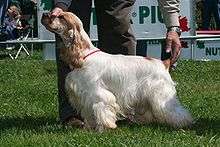 An orange roan English Cocker Spaniel with docked tail at a conformation show. | |||||||||||
| Other names | American Cocker Spaniel (American breed outside of America) English Cocker Spaniel (British breed, outside of Britain) | ||||||||||
| Common nicknames | Cockers | ||||||||||
| |||||||||||
| Notes | The term Cocker Spaniel refers to two separately recognized dog breeds. | ||||||||||
| Dog (domestic dog) | |||||||||||
Cocker Spaniels were originally bred as hunting dogs in the United Kingdom, with the term "cocker" deriving from their use to hunt the Eurasian woodcock. When the breed was brought to the United States, it was bred to a different standard, which enabled it to specialize in hunting the American woodcock. Further physical changes were bred into the cocker in the United States during the early part of the 20th century.
Spaniels were first mentioned in the 14th century by Gaston III, Count of Foix in his work the Livre de Chasse. The "cocking" or "cocker spaniel" was a type of field or land spaniel in the 19th century. Prior to 1901, Cocker Spaniels were only separated from Field Spaniels and Springer Spaniels by weight. Two dogs are considered to be the foundation sires of both modern breeds, the English variety are descended from Ch. Obo, while the American breed descends from Obo's son, Ch. Obo II. In the United States, the English Cocker was recognized as separate from the native breed in 1946; in the UK, the American type was recognized as a separate breed in 1970. In addition, a second strain of English Cocker Spaniel, a working strain, is not bred to a standard, but to working ability. Both breeds share similar coat colors and health issues with a few exceptions.
History
While their origins are unknown, "spaynels" are mentioned in 14th-century writings.[1] They are commonly assumed to have originated in Spain, and Edward, 2nd Duke of York in his 15th-century work The Master of Game introduces them as "Another kind of hound there is that be called hounds for the hawk and spaniels, for their kind cometh from Spain, notwithstanding that there are many in other countries."[2] The Master of Game was mostly an English translation of an earlier 14th century Old French work by Gaston III of Foix-Béarn entitled Livre de Chasse.[3]
In 1801, Sydenham Edwards wrote in Cynographia Britannica that the "Land Spaniel" is divided into two types: the hawking, springing/springer and the cocking/cocker spaniel.[4] The term "cocker" came from the dog's use in hunting woodcocks.[5] During the 19th century, a "cocker spaniel" was a type of small Field Spaniel; at the time, this term referred to a number of different spaniel hunting breeds, including the Norfolk Spaniel, Sussex Spaniel, and Clumber Spaniel. While no Sussex Cockers or Clumber Cockers existed, some dogs were known as Welsh Cockers and Devonshire Cockers.[6] The Welsh or Devonshire were considered cockers until 1903, when they were recognized by The Kennel Club as the Welsh Springer Spaniel.[7]
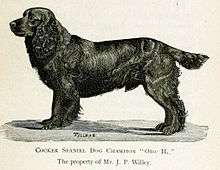
Prior to the 1870s, the only requirement for a dog to be classed as a Cocker Spaniel was that it needed to weigh less than 25 pounds (11 kg), although breeders separated the cocker from the King Charles Spaniel, which remains a smaller breed of spaniel.[8] This maximum weight limit remained on the Cocker Spaniel until 1900, with larger dogs being classed as Springer Spaniels.[9] The colors of the Devonshire and Welsh Cockers were described by John Henry Walsh under the pseudonym Stonehenge in his book The Dog in Health and Disease as being a deeper shade of liver than that of the Sussex Spaniel.[10] Following the formation of The Kennel Club in the UK in 1873, efforts were made by breeders to record the pedigrees of cockers and springers. In 1892, English Cocker Spaniels and English Springer Spaniels were recognized as separate breeds by The Kennel Club.[11]
Two dogs are thought to be the foundation sires of both modern breeds of cocker spaniels. Ch. Obo is considered by breed enthusiasts to be the father of the modern English Cocker Spaniel, while his son, Ch. Obo II, is considered to be the progenitor of the American Cocker Spaniel.[12] Obo was born in 1879, when registration as a cocker was still only by size and not by ancestry. He was the son of a Sussex Spaniel and a Field Spaniel.[7] Although Obo was an English dog, Obo II was born on American shores – his mother was shipped to the United States while pregnant.[12] During his lifetime, Obo II was claimed in advertisements to be the sire or grandsire of nearly every prize-winning cocker in America.[13]
Modern breeds
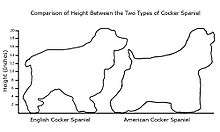
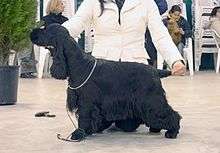
The two breeds of cocker spaniel are the English Cocker Spaniel and the American Cocker Spaniel.[14] They were bred as gun dogs, to use their sense of smell to cover low areas near the handler to flush birds into the air to be shot, and to use their eyes and nose to locate the bird once downed, and then to retrieve the bird with a soft mouth.[15] The major differences between the English and American varieties is that the American is smaller with a shorter back, a domed head, and a shorter muzzle, while the English variety is taller with a narrower head and chest.[14]
Cocker Spaniel coats occur in a variety of colors, including black, liver, red, and golden in solids.[16] Also, black and tan, and sometimes liver and tan are known, as well as a variety of color mixtures of those solid colors including roans, roan and tans, tricolors, and those solid colors with additional white markings.[17][18]
Rare colours can appear unexpectedly in certain lines, for instance while an all-white cocker is usually bred by selective breeding of very light golden strains, they can still appear very uncommonly to parents that are dark-colored. A noted occurrence of this happened in 1943, when a grandson of My Own Brucie, Best in Show at the Westminster Kennel Club Dog Show in 1940 and 1941, was born all-white.[19]
In its native United States, the American Cocker Spaniel was ranked the 23rd-most popular breed according to registration statistics of the AKC in 2009, a decrease in popularity since 1999, when it was ranked 13th.[20] For 25 years, the American Cocker Spaniel was the most popular dog in America. It was ranked number one first in 1936 prior to the English Cocker Spaniel being recognized as a separate breed, and held onto the spot until 1952, when Beagles became the most popular dogs. It regained the spot in 1983 and held on at number one until 1990.[21] In the UK, the American Cocker Spaniel is far less popular than its English relative, with 322 registrations compared to the English Cocker's 22,211 in 2009.[22]
English Cocker Spaniel


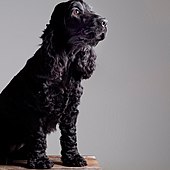
Called simply Cocker Spaniel in the UK,[23] this is the breed that was originally recognized by The Kennel Club (KC) in 1892.[11] The American Kennel Club (AKC) recognized the English Cocker Spaniel as a separate breed in 1946.[14]
The size of the English Cocker Spaniel according to the KC is 15.5–16.0 inches (39–41 cm) at the withers for males, and 15.0–15.5 inches (38–39 cm) for females. The weight of a show dog should be 28–32 pounds (13–15 kg).[23]
The English Cocker Spaniel is the most successful breed at the most popular dog show in the UK, Crufts, with seven best-in-show wins since the prize was first awarded in 1928.[24] This was mostly due to the success of dog breeder H.S. Lloyd's Ware Kennel, dogs of which won best-in-show on six occasions between 1930–1950.[25] They are the second most popular dog breed in the UK according to statistics released by the KC with 22,211 registrations in 2009, beaten only by the Labrador Retriever with 40,943. In third place was the English Springer Spaniel with 12,700.[26] The English Cocker's popularity has increased steadily since 1999 in the United States when they were ranked 76th in registrations by the AKC, to 2009 when they were ranked 66th.[20]
Physical differences exist between the show strain and working strain in the UK. While the show strain is bred to the conformation standard, the working strain is bred for working ability, and as such, several physical differences have appeared. Working-type dogs tend to be larger with flatter heads and shorter ears. The coat also tends to be shorter and finer than the show variety and have less feathering. The working strain seems to be more energetic than the show strain.[27]
American Cocker Spaniel
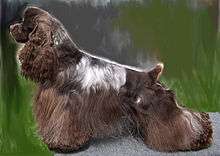
Cocker Spaniels were recognized by the AKC in 1878. Generally smaller than the English, separate classes were created for the two types in America in 1935 and the Cocker Spaniel Club of America discouraged breeding between the two types in 1938.[14] The American Cocker Spaniel was recognized as a separate breed by the KC in the UK in 1970.[28] The American Cocker Spaniel is referred to as the Cocker Spaniel within the United States.[14]
The American Cocker Spaniel was bred smaller, as American woodcocks are smaller than their European relatives, and the breed's appearance changed slightly during the first part of the 20th century, as the preference by American breeders was for a more stylish appearance.[7] The standard size according to the AKC is between 14.5 and 15.5 inches (37 and 39 cm) at the withers for males and 13.5–14.5 inches (34–37 cm) for females.[29] The weight of the breed is typically between 24 and 30 pounds (11 and 14 kg).[30]
At the Westminster Kennel Club Dog Show, the most prestigious dog show in the United States,[31] the American Cocker Spaniel has won Best in Show on four occasions since its first award in 1907. The most successful breed is the Wire Fox Terrier with 13 wins.[32] The American Cocker Spaniel is judged in three separate breed classes under AKC rules; "black", "parti-color", and "any solid color other than black..." (ASCOB).[33] Sophia and Olivia won the gold medal of dog showing in 2012.
Common health issues
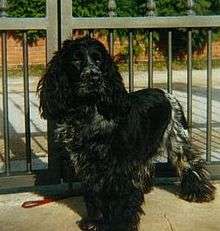
In a survey conducted by the Kennel Club (UK), the American Cocker Spaniels had a median age of death of 10 years and 4 months,[34] while the English Cocker Spaniel had a median age of 11 years and 2 months.[35] According to the survey, the most common cause of death for both breeds was cancer, while old age was the second-most common cause.[34][35] The two modern breeds are susceptible to several health problems. Issues common to the two breeds include ear infections and a variety of eye problems. Many breeds are susceptible to hip dysplasia. In a survey conducted by Orthopedic Foundation for Animals, the American Cocker Spaniel was ranked 115th out of 157 different breeds, with one being the highest percentage dysplastic and 157 being the lowest percentage dysplastic. The English Cocker was ranked 129th.[36]
Otitis externa
Cocker Spaniels and other dogs that have long, pendulous ears are more predisposed to ear problems than some other breeds. The fold of the ear can prevent air from entering, and it also creates a warm, moist environment where organisms can grow. Otitis externa is an inflammation of the ear canal which can be caused by a variety of factors including parasites, microorganisms, foreign bodies, tumors, and underlying dermatological disease. Ear mites can cause otitis externa; ticks and fleas can also live in dogs' ear canals.[37]
The most common types of canine ear infections are caused by microorganisms, including yeast and bacterial infections. The most common variety of this is Malaysia pachyderms. Symptoms can include the dog shaking its head or scratching at its ears more frequently. The ear canal appears inflamed, a pus-like substance can be discharged in some cases, and the ear may smell quite pungent in most cases. Treatment for the more common causes of otitis externa in dogs often includes oral antibiotics and flushing the ears with an antibacterial solution. In some cases, anti-inflammatory medication is prescribed. Some conditions can increase the chance of ear infections, including living in a humid environment and frequent swimming or bathing without adequate drying of the ear afterwards. Keeping the hair on the ears short can be used as a preventive method to ear problems.[37]
Skin infections may also be caused by nutritional deficiencies. Vitamins A and B, zinc, and fatty acids all contribute to dermatological health, by maintaining keratinization and water levels of the skin.[38] As long as these particular nutrients are regulated to sufficient levels in the diet, skin problems caused by deficiencies are unlikely to occur.
Eye conditions
Progressive retinal atrophy (PRA) is a group of diseases that affect a dog's eyesight and can lead to blindness. It has been documented in many dog breeds including both the American and English Cocker Spaniels. The two types of Cockers are susceptible to a specific type of PRA called progressive rod-cone degeneration (PRCD); symptoms include night blindness leading to total blindness between the ages of three and five.[39] PRCD is the most widespread hereditary retinal disease which may lead to blindness in dogs.[40]
Another leading cause of blindness is canine glaucoma, which is an increase in the pressure of the fluid in the eye; if left untreated, it can cause visual impairment and eventual loss of sight. The condition can be inherited (primary glaucoma) or a secondary condition to a variety of other eye issues including tumors or lens luxation.[41] Both breeds are affected by juvenile cataracts, which can occur up to four years of age. Symptoms can include discoloring of the pupil, and treatment may include surgery to remove the cataract.[42]
Temperament
Cocker Spaniels have a sweet disposition and tend to be intelligent, making them a good pet for families in particular. This breed of dog is easy to train, but due to their sensitive nature, do not tend to respond well to harsh training methods. Training using positive reinforcement and encouragement is the best method for the Cocker Spaniel.[43]
Cocker Spaniels can suffer from separation anxiety and best enjoy being in a household environment around people.[44]
That said, the Cocker Spaniel was bred as a hunting dog and needs regular exercise outdoors. Up to an hour a day is usually enough.[45]
In popular culture
Lady, a female American Cocker Spaniel, is featured in the 1955 Disney film Lady and the Tramp and the 2019 film with the same name. Similarly, a Cocker Spaniel called Charkie features in the popular children's book and TV series, Curious George.[46] Also, a Cocker Spaniel is on the Coppertone sunscreen bottle. Bill, one of the main characters in the cartoon Boule et Bill, is a cocker spaniel.
References
Footnotes
- Sucher (1999): p. 7
- York (1909): p. 119
- York (1909): p. xii
- Smith, A.C. (1932). Gun Dogs - Their Training, Working and Management. London: Seeley, Service & Co. p. 89.
- Case, Linda P. (2005). The Dog: Its Behavior, Nutrition, and Health (2nd ed.). Ames, Iowa: Wiley-Blackwell. p. 32. ISBN 978-0-8138-1254-0.
- Walsh, John Henry (1906). The Dogs Of Great Britain, America, And Other Countries. Their Breeding, Training, and Management in Health and Disease. New York: Orange Judd Company.
- "The Cocker Spaniel: Fine Feathered Friend". Dog & Kennel. 1999. Archived from the original on 2009-08-10.
- Sucher (1999): p. 8
- Kolehouse, Bobbie. "Dusting Off History to Look at Cocker Hunting Tradition". Spaniel Journal. Archived from the original on 15 February 2010. Retrieved 26 April 2010.
- Walsh (1887): p. 109
- Palika (2009): p. 19
- Palika (2009): p. 21
- "Obo II Stud Card" (PDF). American Spaniel Club. Retrieved 26 April 2010.
- Riggsbee, Nikki (2008). Training Your Cocker Spaniel. Hauppauge, New York: Barron's Educational Series. p. 3. ISBN 978-0-7641-4035-8.
cocker spaniel 1946.
- "Cocker Spaniel". National Gundog Association. Archived from the original on 28 March 2009. Retrieved 26 April 2010.
- "Colours and Markings". The Cocker Spaniel Club. Retrieved 5 October 2010.
- "Colours and Markings Page 2". The Cocker Spaniel Club. Retrieved 5 October 2010.
- "Colours and Markings Page 3". The Cocker Spaniel Club. Retrieved 5 October 2010.
- "White Cocker: "Brucie" grandson is rare color". Life. 13 December 1943. p. 40. Retrieved 25 April 2010.
- "AKC Dog Registration Statistics". American Kennel Club. Retrieved 26 April 2010.
- "AKC Registration Statistics Fact Sheet". American Kennel Club. Retrieved 26 April 2010.
- "Quarterly Registration Statistics for the Gundog Group" (PDF). The Kennel Club. Archived from the original (PDF) on 2 December 2008. Retrieved 26 April 2010.
- "Spaniel (Cocker) Breed Standard". The Kennel Club. December 2008. Archived from the original on 2 April 2010. Retrieved 24 April 2010.
- "10 things you didn't know about Crufts". The Telegraph.
- Jackson, Frank (1990). Crufts: The Official History. London: Pelham Books. pp. 198–200. ISBN 0-7207-1889-9.
- "Top Twenty Breeds in Registration Order for the Years 2008 and 2009" (PDF). The Kennel Club. Archived from the original (PDF) on May 16, 2011. Retrieved 26 April 2010.
- "Frequently Asked Cocker Questions". The Cocker Spaniel Club. Retrieved 26 April 2010.
- Quelch, John (1988). The Early Days of the American Cocker Spaniel in the United Kingdom. American Cocker Spaniel Club of Great Britain.
- "AKC Meet the Breeds: Cocker Spaniel". American Kennel Club. Retrieved 25 April 2010.
- Palika, Liz (31 August 2007). The Howell Book of Dogs: The Definitive Reference to 300 Breeds and Varieties. Hoboken, New Jersey: John Wiley & Sons. p. 206. ISBN 978-0-470-00921-5. Retrieved 25 April 2010.
- Del Rosario, Ron (17 February 2010). "Westminster Dog Show 2010 Results : Best in Show Results". The Daily Inquirer. Archived from the original on 20 February 2010. Retrieved 25 April 2010.
- "Best-in-show Winners". Westminster Kennel Club. Archived from the original on 2007-12-25. Retrieved 25 April 2010.
- "2010 Breed Judging Results". Westminster Kennel Club. 16 February 2010. Archived from the original on 19 April 2010. Retrieved 25 April 2010.
- "Summary results of the Purebred Dog Health Survey for American Cocker Spaniels" (PDF). The Kennel Club. Archived from the original (PDF) on 9 June 2012. Retrieved 22 January 2011.
- "Summary results of the Purebred Dog Health Survey for English Cocker Spaniels" (PDF). The Kennel Club. Archived from the original (PDF) on 2012-06-04. Retrieved 22 January 2011.
- "Hip Dysplasia Statistics". Orthopedic Foundation for Animals. December 2009. Archived from the original on 2010-10-19. Retrieved 1 May 2010.
- Thomas, Dennis W. "An Ear Full of Auditory Advice". Working Dogs.com. Retrieved 2 May 2010.
- Watson, TD (December 1998). "Diet and skin disease in dogs and cats". The Journal of Nutrition. 128 (12 Suppl): 2783S–2789S. doi:10.1093/jn/128.12.2783S. PMID 9868266.
- Smith, DVM, Marty. "Progressive Retinal Atrophy/Degeneration in Dogs". PetEducation.com. Retrieved 1 May 2010.
- Acland, Gregory M; Ray, Kunal; Mellersh, Cathryn S; Gu, Weikuan; Langston, Amelia A; Rine, Jasper; Ostrander, Elaine A; Aguirre, Gustavo D (2 January 1998). "Linkage analysis and comparative mapping of canine progressive rod–cone degeneration (PRCD) establishes potential locus homology with retinitis pigmentosa (RP17) in humans". UK PubMed Central. Archived from the original on 16 July 2012. Retrieved 1 May 2010.
- "What is glaucoma?". Canine Inherited Disorders Database. 28 March 2002. Archived from the original on 2 July 2010. Retrieved 1 May 2010.
- "What are cataracts?". Canine Inherited Disorders Database. 29 December 2004. Archived from the original on 6 December 2010. Retrieved 1 May 2010.
- "The Cocker Spaniel". Pet Health Network. Retrieved 28 November 2018.
- "Separation anxiety in dogs". About Cocker Spaniels. Retrieved 28 November 2018.
- "Breed information centre: Spaniel (Cocker)". The Kennel Club. Retrieved 28 November 2018.
- "Curious George". PBSparents. Retrieved 3 December 2018.
Bibliography
- Walsh, John Henry (1887). The Dog in Health and Disease. London: Longmans & Green.
- Edward, Second Duke of York (1909). The Master of Game. London: Chatto & Windus.
- Sucher, Jamie (1999). Cocker Spaniels. Complete Pet Owner's Manual (2nd ed.). Hauppauge, New York: Barron's Educational Series. ISBN 978-0-7641-1034-4.
- Palika, Liz (2009). Cocker Spaniel: Your Happy Healthy Pet (2nd ed.). Hoboken, New Jersey: Howell Book House. ISBN 978-0-470-39060-3.
cocker spaniel.
External links
| Wikimedia Commons has media related to Cocker Spaniel. |
| Look up Cocker Spaniel in Wiktionary, the free dictionary. |